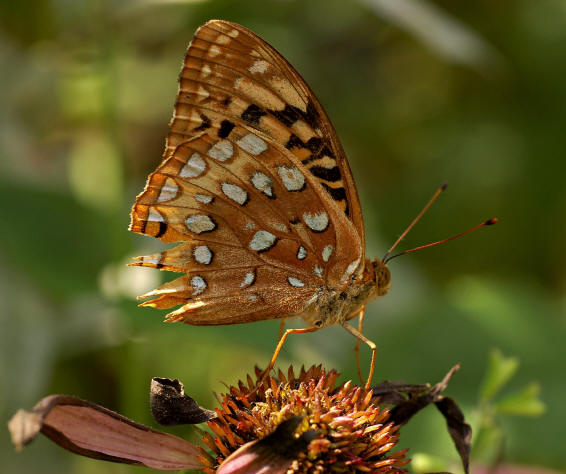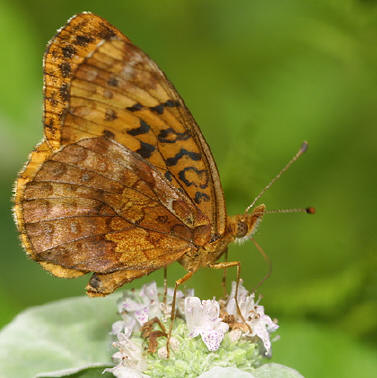Until this summer violets were a plague in the cultivated areas of my garden. Under every expanding clump of the purple-flowering plants there were hundreds of tiny seedlings. The violets even prefer to grow mingled tightly with my perennials. Like most gardeners, I grubbed them out before they could take over.
As I was doing just that one sweaty day last August, a Great Spangled Fritillary butterfly (Speyeria cybele) gently settled among them and began laying her eggs. These are large butterflies, orange with black spots on their upper wings and pretty silver spots on the underside of their hind wings. They are among my favorite insects. Clearly, violets
have a role that I didn’t know about. I needed to learn more.

The larvae of most butterflies feed on at least a few different plants, but Great Spangled Fritillaries depend exclusively on several varieties of violets, just as the more famous Monarch butterfly caterpillars dine solely on various kinds of milkweed. Without violets, I learned, these beautiful butterflies would not decorate our gardens. With such
a restricted diet, their caterpillars are not garden pests, although violets do look tattered by late fall. The caterpillars feed at night and crawl away from violets to hide during the day. They are difficult to find, dark brown to black with black spines that are orange at the base. Even with a flashlight, I have never found one. But the butterflies live in my garden,
and my violets are chewed. I think it’s a fair price to pay.
These gorgeous butterflies range coast to coast from the southern edge of Canada southward to northern California through Colorado and Nebraska to Virginia. There are reports that this range is shifting southward as habitat is lost to the North.
Adult Great Spangled Fritillaries appear in the spring from May to June, their mating season. Afterward, the females go into hiding until late summer when they reappear to lay their eggs. They are swift fliers, but you can often get a good look at them feeding on flower nectar. They especially like black-eyed susans, our state flower. Eggs hatch in
the fall, and caterpillars overwinter before pupating and emerging as adults in the late spring. The pupae resemble mottled, brown leaves. Fritillary caterpillars and pupae are as hard to find as the adults are hard to miss.
 Here in the Mid-Atlantic we are fortunate to live within the overlapping ranges of the Great Spangled Fritillary and the similar but smaller Meadow Fritillary (Boloria bellona). Meadow Fritillaries also depend on violets, but they have been seen sampling other plants from
time to time. They are active from May to September and produce two or three broods. The caterpillars are purple to black with brown spines. The last generation of caterpillars overwinters like their larger relatives.
Here in the Mid-Atlantic we are fortunate to live within the overlapping ranges of the Great Spangled Fritillary and the similar but smaller Meadow Fritillary (Boloria bellona). Meadow Fritillaries also depend on violets, but they have been seen sampling other plants from
time to time. They are active from May to September and produce two or three broods. The caterpillars are purple to black with brown spines. The last generation of caterpillars overwinters like their larger relatives.
Even after learning all this, I still don’t want violets to take over my garden. But I cannot be without Fritillaries fluttering about all summer. My solution is an experiment, but I think it will succeed. Since I am a strong believer in the work-reducing advantages of ground covers, I decided that a large patch of violets will be perfect beneath
some of my river birches. The trees are away from the house so the chewed violet foliage won’t matter. Now when I grub violets out, I replant them under the birches.
Better yet, I’ve come to see tattered violets as cheerful promises for next spring. I must admit, though, that once in a while I scatter a little non-toxic (to pets and children) slug bait, just to ensure that the violets are feeding only butterflies!
Read other articles on birds, wildlife & beneficial insects